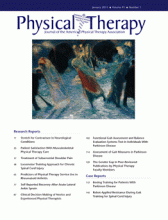Abstract
Background Impaired walking limits function after spinal cord injury (SCI), but training-related improvements are possible even in people with chronic motor incomplete SCI.
Objective The objective of this study was to compare changes in walking speed and distance associated with 4 locomotor training approaches.
Design This study was a single-blind, randomized clinical trial.
Setting This study was conducted in a rehabilitation research laboratory.
Participants Participants were people with minimal walking function due to chronic SCI.
Intervention Participants (n=74) trained 5 days per week for 12 weeks with the following approaches: treadmill-based training with manual assistance (TM), treadmill-based training with stimulation (TS), overground training with stimulation (OG), and treadmill-based training with robotic assistance (LR).
Measurements Overground walking speed and distance were the primary outcome measures.
Results In participants who completed the training (n=64), there were overall effects for speed (effect size index [d]=0.33) and distance (d=0.35). For speed, there were no significant between-group differences; however, distance gains were greatest with OG. Effect sizes for speed and distance were largest with OG (d=0.43 and d=0.40, respectively). Effect sizes for speed were the same for TM and TS (d=0.28); there was no effect for LR. The effect size for distance was greater with TS (d=0.16) than with TM or LR, for which there was no effect. Ten participants who improved with training were retested at least 6 months after training; walking speed at this time was slower than that at the conclusion of training but remained faster than before training.
Limitations It is unknown whether the training dosage and the emphasis on training speed were optimal. Robotic training that requires active participation would likely yield different results.
Conclusions In people with chronic motor incomplete SCI, walking speed improved with both overground training and treadmill-based training; however, walking distance improved to a greater extent with overground training.
Footnotes
Both authors provided concept/idea/research design and writing. Dr Roach provided data analysis. Dr Field-Fote provided project management, fund procurement, participants, and facilities/equipment. The authors acknowledge the contributions of the staff of the Neuromotor Rehabilitation Research Laboratory at The Miami Project to Cure Paralysis, especially Saumitra Sinha Ray, Kathleen Manella, Stephen Lindley, Rebecca Avshalom, and Lea Lenahan.
Funding support for this study was provided by National Institutes of Health grant R01HD41487 (to Dr Field-Fote) and The Miami Project to Cure Paralysis.
ClinicalTrials.gov registration number: R01HD41487.
- Received November 3, 2009.
- Accepted September 2, 2010.












